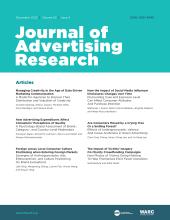Abstract
Whereas the need for integrated marketing communication has been given considerable attention by researchers in recent decades, the integration of creativity into integrated marketing communication has not. Differences between how creativity is valued in advertising versus specialized digital marketing agencies within an integrated marketing communication environment may lead to brand message diffusion. The current study addresses these differences and investigates what defines, drives, and inspires creative collaboration and how it relates to the motivational theory of creativity. Drawing on a social-constructivist methodology, the authors generated empirical data from leaders of industry-acclaimed agencies from four European countries (Norway, Italy, France, and the United Kingdom). On the basis of that data, the authors propose a conceptual model which managers can use as a roadmap for improving the creative integrated marketing communication process, while opening the door to future research possibilities.
- Received January 10, 2022.
- Received (in revised form) August 24, 2022.
- Accepted August 26, 2022.
- Copyright © 2022 ARF. All rights reserved.
ARF MEMBERS
If you are a member of the Advertising Research Foundation, you can access the content by logging in here
Log In
Pay Per Article - You may access this article (from the computer you are currently using) for 30 days for US$20.00
Regain Access - You can regain access to a recent Pay per Article purchase if your access period has not yet expired.





